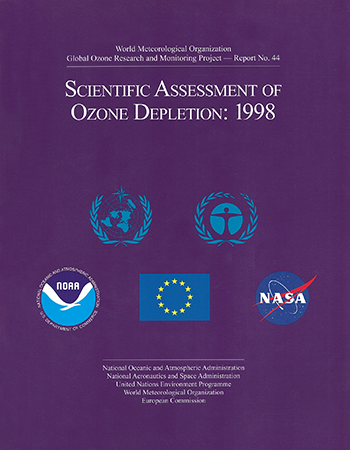Scientific Assessment of Ozone Depletion: 1998

Citations and Copies
The 1998 WMO/UNEP assessment, Scientific Assessment of Ozone Depletion: 1998, contains the understanding of ozone depletion and reflects the thinking of 304 international scientific experts who contributed to its preparation and review. Co-chairs of the 1998 assessment were Dr. Daniel L. Albritton of the NOAA Aeronomy Laboratory, Dr. Robert T. Watson of the World Bank, Dr. Pieter J. Aucamp of the Ptersa Environmental Consultants, and Dr. Gérard Mégie of the Service d'Aéronomie du CNRS. Other members of the Aeronomy Laboratory made substantial contributions to the report, serving as lead authors, co-authors, contributors, reviewers, coordinating editor, and editorial and computing support staff.
This Ozone Assessment includes three major sections – the Executive Summary, 12 detailed chapters in four parts, and Frequently Asked Questions About Ozone:
- Part 1. Halocarbon, Ozone, and Temperature Changes
- Chapter 1. Long-Lived Ozone-Related Compounds (Lead Authors: Ronald G. Prinn and R. Zander)
- Chapter 2. Short-Lived Ozone-Related Compounds (Lead Authors: (Michael J. Kurylo and José M. Rodríguez)
- Chapter 3. Global Distributions and Changes in Stratospheric Particles (Lead Authors: Sophie Godin and Lamont R. Poole)
- Chapter 4. Ozone Variability and Trends (Lead Authors: Rumen D. Bojkov and Robert Hudson)
- Chapter 5. Trends in Stratospheric Temperatures (Lead Authors: Marie-Lise Chanin and V. Ramaswamy)
- Part 2. Advances in Understanding the Processes Involved
- Chapter 6. Upper Stratospheric Processes (Lead Authors: Rolf Müller and Ross J. Salawitch)
- Chapter 7. Lower Stratospheric Processes (Lead Authors: A.R. Ravishankara and Theodore G. Shepherd)
- Chapter 8. Tropospheric Ozone and Related Processes (Lead Authors: Jos Lelieveld and Anne M. Thompson)
- Part 3. Impacts of Ozone Changes
- Chapter 9. Ultraviolet Radiation at the Earth's Surface (Lead Authors: Jay R. Herman and Richard L. McKenzie)
- Chapter 10. Climate Effects of Ozone and Halocarbon Changes (Lead Authors: Claire Granier and Keith P. Shine)
- Part 4. Predictions of Future Changes
- Chapter 11. Halocarbon Scenarios for the Future Ozone Layer and Related Consequences (Lead Authors: Sasha Madronich and Guus J.M. Velders)
- Chapter 12. Predicting Future Ozone Changes and Detection of Recovery (Lead Authors: David J. Hofmann and John A. Pyle)
- Frequently Asked Questions About Ozone (Coordinator: Gérard Mégie)
Executive Summary
The Executive Summary gives a synopsis of major scientific findings of the 12 chapters of the full assessment. This portion includes:
- Preface
- Introduction
- Recent Major Scientific Findings and Observations
- Supporting Scientific Evidence and Related Issues
- Recent Halogen and Methane Changes
- Stratospheric Particles
- Ozone in the Midlatitudes and Tropics
- Ozone in High-Latitude Polar Regions
- Stratospheric Temperatures
- Tropospheric Ozone
- Changes in UV Radiation
- Changes in Climate Parameters
- Future Halogen Changes
- Recovery of the Ozone Layer
- Implications for Policy Formulation
Frequently Asked Questions About Ozone
The international scientific community included this section in their 1998 assessment. In it, they answer several of the general questions that are most frequently asked by students, the general public, and leaders in industry and government. After a general introduction about ozone, the questions addressed are:
- How can chlorofluorocarbons (CFCs) get to the stratosphere if they're heavier than air?
- What is the evidence that stratospheric ozone is destroyed by chlorine and bromine?
- Does most of the chlorine in the stratosphere come from human or natural sources?
- Can natural changes such as the Sun's output and volcanic erruptions be responsible for the observed changes in ozone?
- When did the Antarctic ozone hole first appear?
- Why has an ozone hole appeared over Antarctica when CFCs and halons are released mainly in the Northern Hemisphere?
- Is there an ozone hole over the Arctic?
- Is the depletion of the ozone layer leading to an increase in ground-level ultraviolet radiation?
- Does ozone depletion cause climate change?
- How severe is the ozone depletion now?
- Is the ozone layer expected to recover? If so, when?